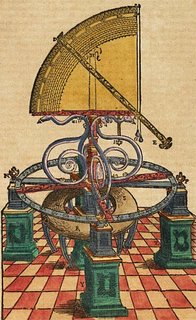"I've studied all available charts of the planets and stars and none of them match the others. There are just as many measurements and methods as there are astronomers and all of them disagree. What's needed is a long term project with the aim of mapping the heavens conducted from a single location over a period of several years." [Tycho Brahe, aged 17]
 Sextans Chalybeus Pro Distantiis Per Unicum Obeservatrem Dimetiendis
Sextans Chalybeus Pro Distantiis Per Unicum Obeservatrem Dimetiendis Steel sextant for measuring distances by one single observer
 Armilae Aeqatoriæ Maximæ Sesquialtero Constantes Circulo
Armilae Aeqatoriæ Maximæ Sesquialtero Constantes Circulo The great equatorial armillary instrument
with one complete circle, and one semicircle
Danish nobleman astronomer, astrologer and alchemist, Tycho Brahe (1546-1601) established with royal patronage his "long term project" at Hven (an island between Denmark and Sweden) where he built his first observatory, Uraniborg.
It was here that he and his assistants constructed massive instruments to help Brahe's assiduous observations (without the aid of a telescope) and calculations in relation to the positions of the heavenly bodies. Alas, none of the instruments has survived.
Privately published in 1598, Astronomiæ Instauratæ Mechanica was actually intended to showcase Brahe's talents in order to secure further funding after a royal death and withdrawl of his allowance. The original woodcuts and engravings were hand coloured and the first trade printing, the year after Brahe's death, only differed by including a portrait of the author.
"The instruments of Tycho Brahe represent a major achievement in astronomical science, because they provided much more accurate readings than previously possible, and on the basis of Tycho Brahe's observations Kepler determined the laws of planetary motions and from these laws Newton discovered the law of gravity. Not until the invention of the telescope some years after Tycho Brahe's death was it possible to get more accurate readings."
- A digitized version of the first printing is online at the Danish Royal Library - The Astronomical Instruments of Tycho Brahe (in english, with transcripts)
- The black and white image above comes from the Smithsonian exhibition - this version has large jpegs of full pages.
- Another version of the 1602 edition at Lehigh University, Pennsylvania (thumbnails).
- Tycho Brahe biography at the University of St Andrews, Scotland.
- Tychobrahe.com - A Universal Website.
- Tycho Brahe curriculum vitae (well, a timeline anyway)
- Wikipedia.
- Tycho Brahe's Nose And The Story Of His Pet Moose.
- Strange Cases from the Files of Astronomical Sociology.














































2 comments :
As charming as ever.What a onderful blog.Thank you!
what do you know about the term "abyssian lines"?
Post a Comment
Comments are all moderated so don't waste your time spamming: they will never show up.
If you include ANY links that aren't pertinent to the blog post or discussion they will be deleted and a rash will break out in your underwear.
Also: please play the ball and not the person.
Note: only a member of this blog may post a comment.